Dirty Cops, Dirty Data
An analysis of Baltimore Police data shows how reform is regularly misrepresented to the public by political leaders and police. (AP Photo/Julio Cortez)
(AP Photo/Julio Cortez)
This is the third and final part in a series of stories from the Real News examining the past 30-plus years of police and crime in Baltimore City.
On the heels of 2023, a year when Baltimore’s annual homicide number significantly declined for the first time in nearly a decade, the Baltimore Police held a press conference to celebrate what public officials and the Department of Justice called “a significant milestone.”
That early 2024 “milestone”: two of the many reforms required by the federal consent decree — the result of a civil rights investigation following the 2015 police killing of Freddie Gray — were recently completed to the approval of the Department of Justice. These completed reforms are related to transporting people in police custody and “officer support and wellness practices.”
At the press conference, City Solicitor Ebony Thompson suggested that 2023’s violence reduction was a result of these reforms. “This milestone is occurring at a time when the city is achieving a recent and historic reduction in violent crime,” Thompson said, calling the reforms “a testament to the effectiveness of constitutional and community focused policing.”
Over the previous seven years, only around 5% of the consent decree-mandated reforms have been completed.
Another way of looking at this “milestone”: over the previous seven years, only around 5% of the consent decree-mandated reforms have been completed. Following Gray’s death, a Department of Justice civil rights investigation revealed a staggering pattern and practice of civil rights violations and discriminatory policing. As a result of that investigation, the Baltimore Police Department entered into a federal consent decree in April 2017. Seven years later, the most significant elements of the consent decree, regarding police misconduct (including use of force), have barely even begun. WYPR reported that “about 15% of the decree hasn’t been touched yet.”
That means the claim being made, really, is that murders have declined because police are reducing the number of “rough rides” and also receiving more wellness support — a specious connection, and an example of how reform is regularly misrepresented to the public by political leaders and police.
As the Baltimore Police Department goes through another year under the consent decree, with changes to the department slow going, TRNN found that Baltimore data transparency and retention has gotten worse and its numbers have become increasingly unreliable.
This is a story of how much we do not know.
Deeply flawed data
The Baltimore City Police Department provides Open Baltimore, the city’s publicly accessible data hub, with data about crime and police activity. Baltimore’s political leaders and police pride themselves on data access and transparency. These datasets are often used as research tools for citizens, reporters, and those in policy development and law enforcement. Indeed, everyone is encouraged to consult Open Baltimore.
But we found these datasets to be deeply flawed in ways that would make any conclusions drawn from them unsound — especially for governance and policing. The arrest data in Open Baltimore demonstrates that, contrary to what would be expected, data gathering by police has become less comprehensive and more faulty since the implementation of the federal consent decree.
Specifically, there are significant differences between Open Baltimore arrest data and Uniform Crime Report data. UCR is provided to the FBI by law enforcement offices all over the country each year and was, for decades, the most referenced and most frequently cited dataset about crime. There are flaws with UCR, including the problem with all law enforcement data: it is self-reported by law enforcement.
There are significant differences between Open Baltimore arrest data and Uniform Crime Report data.
That said, UCR data for 1990-2020 was provided to TRNN by Baltimore Police via a public information request, making it the most comprehensive data set available for such a long period of time.
The number of arrests recorded in Open Baltimore data varies significantly from the numbers in UCR, often by thousands. Baltimore Police provide data to both the FBI and Open Baltimore, making the cause of differences between the two datasets especially confounding. Additionally, there are a significant number of arrests not included in the Open Baltimore dataset, and the differences between the numbers recorded in UCR and Open Baltimore data have widened over time. Arrests seemingly disappear from Open Baltimore.
In February 2023, we pulled an arrest data file from Open Baltimore. In the arrest data between the years 2010-2020, a total of 335,805 arrests were shown.
That same arrest file was pulled four months later, in June. There were 386 fewer arrests.
An additional data analysis was completed in January 2024. The same trend continued, at a much greater rate. In the course of nearly a year, more than 4,300 arrests were removed from the total for 2010-2020.
| Year | # of arrests 2/8/23 | # of arrests 6/23/23 | # of arrests 1/24/24 | Difference (Feb. 2023-June 2023) |
Difference (Feb. 2023-Jan. 2024) |
|---|---|---|---|---|---|
| 2010 | 45,560 | 45,515 | 45,224 | -45 | -336 |
| 2011 | 43,704 | 43,667 | 43,364 | -37 | -340 |
| 2012 | 42,681 | 42,632 | 42,333 | -49 | -348 |
| 2013 | 39,866 | 39,821 | 39,542 | -45 | -324 |
| 2014 | 37,495 | 37,447 | 37,078 | -48 | -417 |
| 2015 | 26,084 | 26,059 | 25,732 | -25 | -352 |
| 2016 | 23,420 | 23,402 | 23,089 | -18 | -331 |
| 2017 | 22,493 | 22,428 | 21,989 | -65 | -504 |
| 2018 | 20,940 | 20,912 | 20,543 | -28 | -397 |
| 2019 | 19,622 | 19,601 | 19,407 | -21 | -215 |
| 2020 | 13,940 | 13,935 | 13,162 | -5 | -778 |
| Total | 355,805 | 335,419 | 331,463 | -386 | -4342 |
When we spoke to Baltimore City employees, including representatives from Open Baltimore and Baltimore Police, their reason for removing previously recorded arrests from Open Baltimore’s data was unclear. Arrests that are documented but do not result in a charge, or are accidentally duplicated or inaccurately entered are removed during reviews by police. Additionally, the police explained that expungements may have something to do with the lower numbers of arrests. They could not tell us how frequently arrests are removed for either of those reasons.
This arrest data is frequently cited. One recent example of Open Baltimore’s flawed year-to-year data being cited is the Baltimore Banner’s 2022 analysis of arrests. At the end of 2022, the Banner reported that arrests had increased for the first time in nearly a decade. While the broad conclusions are correct — based on the data, arrests did slightly increase in 2022 — the year-to-year arrest numbers cited by the Banner are quite different from past UCR numbers and contemporaneous reporting, because the number of arrests recorded in those years in Open Baltimore have declined.
Open Baltimore provides an increasingly incomplete picture of police activity from the past as each dataset gets older.
Whatever the reason for the lowered arrest numbers, it means that Open Baltimore provides an increasingly incomplete picture of police activity from the past as each dataset gets older. It is not a record of those people who were handcuffed and arrested at a specific point in time — their lives put on hold for weeks, months or years — but a record of how some of those arrests were processed long after that, based on an unknown and unnamed number of factors.
A recent review of Open Baltimore shows that, months after our year-long analysis, arrest data continues to decline.
TRNN also looked at geographic location data within Open Baltimore’s arrest data. Over the past 13 years, Open Baltimore’s arrest data is missing locations in, on average, 37% of arrests. That percentage increased from 4% in 2010 to as high as 61% in 2022.
The percentage of missing data has increased significantly since 2015 when the city police were put under increased scrutiny following Gray’s death (46% missing location data) and in 2017 (49% missing data) when the consent decree was implemented.
| Year | # of arrests with missing location data 1/24/2024 | Total arrests 1/24/2024 | % of arrests with missing location data |
|---|---|---|---|
| 2010 | 1,646 | 45,224 | 3.6% |
| 2011 | 13,573 | 43,364 | 31.3% |
| 2012 | 12,640 | 42,333 | 29.9% |
| 2013 | 11,876 | 39,542 | 30.0% |
| 2014 | 14,485 | 37,078 | 39.1% |
| 2015 | 11,727 | 25,732 | 45.6% |
| 2016 | 10,836 | 23,089 | 46.9% |
| 2017 | 10,814 | 21,989 | 49.2% |
| 2018 | 10,545 | 20,543 | 51.3% |
| 2019 | 10,550 | 19,407 | 54.4% |
| 2020 | 7.394 | 13,162 | 56.2% |
| 2021 | 6,434 | 11,130 | 57.8% |
| 2022 | 7,605 | 12,360 | 61.5% |
| 2023 | 7,971 | 13,594 | 58.6% |
| Total | 138,096 | 368,547 | 37.5% |
It is unclear whether this location-based data is missing from police records as well, or if police records maintain this data with locations and, for reasons unknown, it was not given to Open Baltimore.
One more example of how poor data entry has been in Baltimore: throughout the ’90s, there are entries in Maryland Case Search in which the officer name is “Officer, Police” or “Police, Officer.” Over 500 of these results are for arrests in Baltimore City where the last name is “Officer.” There are over 300 where the first name is “Police” and nearly 300 where the first name is “Baltimore.” That data entry in the ’90s was poor is hardly a surprise. That these “Officer, Police” permutations have stood for decades in the database shows that data cleansing and validation has never been prioritized.
Representatives from city government, including Open Baltimore, seemed entirely unaware of these problems with Open Baltimore’s data until we brought them to their attention. After months seeking comment or explanation, Open Baltimore was not able to provide a thorough explanation.
In a city where policing is scrutinized for bias and professionalized for data gathering, and police enforcement itself is informed by targeting “microzones,” the lack of comprehensive location data (nearly 40% is missing) available to the public is troubling.
A history of dirty data
While there are problems with the police records provided to Open Baltimore, the unreliability of Baltimore crime data has been a decades-long problem. Collection and reporting of crime data has been a hotly contested issue in Baltimore, and the data provided has been frequently insufficient, unsound and in some cases manipulated.
In the ’90s — the decade leading up to “zero tolerance” — then-Councilperson Martin O’Malley and others accused Mayor Kurt Schmoke of adjusting statistics to make crime seem lower than it actually was. Police Commissioner Thomas Frazier’s report in the mid-’90s about nonfatal shooting reductions was also challenged.
After O’Malley was elected mayor in 1999, he commissioned an audit which found violent crime was frequently downgraded. As a result of the audit, thousands of felonies were added to the official number for 1999. This also had the effect of making any decrease in crime during the first year of the O’Malley administration even more dramatic.
O’Malley would later be accused of the same sort of statistical manipulation. In 2001, O’Malley said there were 78,000 arrests, but the official number was 86,000. Official arrest numbers for 2005 are around 100,000, while the ACLU claimed there were 108,000.
The unreliability of Baltimore crime data has been a decades-long problem.
In 2006, WBAL investigative reporter Jayne Miller (a TRNN contributor) revealed that police were simply not counting all of the violent crimes reported. For example, Miller found that “police wrote no report of a shooting … despite locating and interviewing the intended target, who was not hurt. Instead, the officers combined the incident with armed robbery that occurred earlier that night in the same area — a practice known as duplicating.”
After 2006, the department shifted away from mass arrest toward what they framed as more “targeted” styles of policing, focused on violent offenders rather than low-level offenders. Data from these years showed a decrease in low-level offenses but did not show an increase in the enforcement of violent crimes. A policy of greater focus on guns and gun possession during this period is also not reflected in the data. Gun seizures were much higher in the ’90s than in the period where gun policing was supposedly the focus.
In our reporting, we also learned that gun seizure data — another metric often cited by the police to illustrate how hard police are working to get guns “off the street” and reduce violence — includes guns given to the police during gun buyback programs. For example, in 2017 there were 1,917 gun seizures. In 2018, there were 3,911. The reason for that jump was not the result of increased enforcement or a jump in the rate of illegal gun possession, it was because the city resurrected its gun buyback program. That 2018 buyback resulted in 1,089 guns handed over to police.
Willingly handing over a gun to police in exchange for cash is most likely not what the public imagines when police announce the total of gun “seizures” in a year.
Baltimore Police do not provide data about nonfatal shooting numbers before 1999 because, police told us, the department does not have the ability to easily extract this number from the broader aggravated assault category that shootings were once categorized under. That means that the police department, whose strategies are often informed by data on shootings and murders, does not have information about the number of nonfatal shootings that occurred before 1999. There is seemingly no way to easily look at how that crucial number has historically changed.
‘We have no idea what is happening’
These problems with data and the lack of transparency are costly. Baltimore spends more per capita on its police department than any other major American city, but the city and department have consistently failed in their oversight of how that money is actually spent, especially on police overtime. Exorbitant overtime is a commonly used indicator when searching for problem police officers and police corruption. For example, members of the infamous Gun Trace Task Force were among the officers who were nearly doubling their salary with overtime. And, as Baltimore Brew reported, the same overtime offenders appeared year after year; the Maryland State Office of Legislative Audits recently found that Baltimore Police “failed to effectively monitor $66.5 million in overtime.”
Police quarreled with the auditor’s conclusions and assured overtime practices would now be reformed and ready by the end of May 2024. They were not. Since 2016, the Baltimore Police has failed overtime audits each year — and each year, police explain that the department needs a little more time to fix overtime.
Baltimore spends more per capita on its police department than any other major American city.
Melissa Schober, a community advocate, has been calling attention to the failed overtime audit by the Baltimore Police for years. She told TRNN that her concerns extend to the broader metrics used by police, not just overtime. Metrics remain oblique and undefined and, according to police, cannot improve because they are contingent upon a police budget they claim is inadequate. The Baltimore City police budget is nearly $600 million per year, Schober stressed.
“My fury isn’t just at the overtime overspending. It is that years after the Fiscal Year 2016 — that’s July 1, 2015, so nearly a decade ago — we are still somehow ‘in progress’ on documenting metrics because carrying those things out are ‘budget dependent,’ but they never manage to say how much they’re short and when they expect to complete the work,” Schober said. “Until and unless the BPD can say, ‘Here’s our outcome and here is the numerator and denominator and here’s how we validate those numbers (or counts), here’s our data dictionary and here’s how we train our folks to count things,’ we have no idea what is happening with money.”
While the city celebrates the “progress” police are making with the federal consent decree, data remains incomplete. Some data-gathering related to the consent decree has not even begun.
The consent decree requires the police to record stop and search data, but, as the Baltimore Banner reported, that has not even started, even though it is perhaps the most crucial way, data-wise, to get a sense of discriminatory and unconstitutional policing. The Baltimore Sun recently reported that Baltimore Police do not keep track of how often its officers get in police chases. Soon after the Sun published its story, police released the data they previously said they did not track.
The refusal to properly collect, let alone share, this data also enables police misconduct. There is no way to determine how often questionable stops occur, because it is only when police stops result in arrests that they are recorded. For defense attorneys, this is not only a gap in data, it’s a convenient way for police not to account for constitutional violations.
The lack of stop-and-search data means constitutional violations are revealed only when they happen to someone arrested for a crime — at which point the constitutional violation is often ignored by prosecutors and judges because the arrestee was found to have broken the law.
“Police are never discouraged from crossing the line when they stop and search someone without probable cause — and they are actually encouraged to cross the line any time they find a gun,” defense attorney and former public defender Natalie Finegar told TRNN.
There is no way to determine how often questionable stops occur, because it is only when police stops result in arrests that they are recorded.
Since 2017, Baltimore Police have relied on an expansive — and controversial — plainclothes policing unit called DAT (District Action Team) whose primary job is gun and drug interdiction. They do this in part by searching people they deem “suspicious” or representing “characteristics of an armed person.” The Baltimore Police argue that this kind of “proactive policing” and these types of questionable stops are vital to violence reduction. The police lack data to back up this claim.
“While it can be difficult to correlate officer proactivity and visibility to what crimes have been prevented, we have seen that when these units are deployed, they have an impact on crime suppression and calming for the community,” Baltimore Police spokesperson Lindsey Eldridge told TRNN.
According to Schober, the problem is not only the inability of police to provide data, but to even explain why certain data points such as “proactive policing” were even analyzed.
“When auditors looked at percent of time spent on proactive policing, the BPD was unable to produce documentation detailing how and why they selected that as a performance measure, and then how they monitored, controlled and analyzed data,” Schober said.
Data’s inconvenient truths
Last year, Baltimore recorded 262 murders, a decline of 70 from 2022 — a “historic” reduction. This drop in murders is notable and important. Far fewer people died in Baltimore from gun violence last year compared to previous years, and these declines have continued into 2024 — as of June, murders had declined by an additional 36%.
Due to population decline, the current drop in murders puts the city’s murder rate — people killed per 100,000 — at almost the exact same place it was in 1990. The use of that 300 number as a benchmark dates to the early ’90s, when the city first surpassed 300 murders per year and also had a significantly higher population. When accounting for population decline, 1990’s 300 murders is the equivalent of around 240 murders.
In 2024, Baltimore will probably have far fewer than even 240 homicides. At the end of June, Baltimore had recorded 89 homicides, which had the city on track to endure fewer than 200 murders for the first time since 2011.
As we saw in the ’90s, New York City’s violence reduction was prematurely credited to “zero tolerance” policies.
The mayor and others have already credited the one-year reduction to its Group Violence Reduction Strategy and other interrelated initiatives. But there is simply no way to look at one or two years of data and make any serious determination as to what caused that decline — especially when violent crime is “dropping fast” nationwide. In 2024, homicides have declined at rates that are even more impressive than last year’s reductions.
As we saw in the ’90s, New York City’s violence reduction was prematurely credited to “zero tolerance” policies. Within a couple of years, the supposed success of “zero tolerance” meant it was exported to cities such as Baltimore and New Orleans. While many scholars have since questioned if “zero tolerance” had much to do with crime reduction, the policy itself, which led to Baltimore police arresting hundreds of thousands for low-level crimes, inarguably caused irreparable harm — especially to Black communities.
Data informs policy creation, so the data should be vetted. During our conversation with city employees who handle and publish data, they described themselves as “like Uber,” which is to say, they are a neutral transporter of data from one place to another. The police send Open Baltimore data and they post it, no questions asked.
So, returning to our initial question, why are arrests being removed from Open Baltimore? If part of this gap between Open Baltimore and UCR data is actually due to expungements, as police claimed, that still creates a problem in the data. An expungement does not mean the arrest did not occur. It means the person who was arrested went through the lengthy process of removing an arrest or charge from their personal criminal record in order to gain employment, rent an apartment or apply for a loan.
If recorded arrests are leaving Open Baltimore because of expungements (or any other reason), police who provide data to Open Baltimore and Open Baltimore itself should account for the change by maintaining a record of removed arrests in the data provided to Open Baltimore. When someone consults Open Baltimore for arrest numbers, they reasonably assume they are getting a record of those arrests for that year, not how those numbers look currently, with arrests removed for reasons that Baltimore Police cannot adequately explain.
With nearly 40% of arrests lacking location data and Open Baltimore’s removed arrests, the data contains too many unknowns.
Past policies have been built upon incomplete and frequently flawed data. Data collection begins with fingers on a keyboard. Data-driven policies are only effective if the data collection and cleansing processes are logical, consistent and thoroughly understood. Poor data collection, for example, can lead to sloppy data entry, which, in turn, leads to dirty data, which then leads to potentially wildly inaccurate conclusions — and therefore faulty and ineffective policy decisions.
Recent changes to data input methods and analysis — that is, changes in the system used to record and categorize this data — make comparisons between years much more difficult. This means residents, reporters and other members of the public cannot easily fact check claims by city officials and law enforcement.
Data informs policy creation, so the data should be vetted.
Cities sometimes change the methods they use to measure crime. In 2021, the FBI retired UCR and began using the National Incident-Based Reporting System instead. NIBRS categorizes data quite differently than UCR. That means that certain crimes may appear to increase or decrease as an effect of recording them in the NIBRS system, not because of a difference in the number. “This does not mean that crime has increased; it just means the way crimes are reported has changed,” Baltimore Police explain on their website.
Recent changes to Baltimore’s police districts mean even short-term comparisons between years or areas of the city are going to be much more difficult. The redistricting of Baltimore’s police department’s districts — for the first time in over 50 years — makes it “impossible” to easily compare police metrics going forward. Indeed, at a Public Safety Committee hearing in late 2023, the data on homicides and nonfatal shootings by district that was presented simply stopped in early July because of redistricting.
Data does not lie, but it often reveals inconvenient truths. But data can be only as truthful as it is complete and accurate. Interrogating the city’s publicly available data reveals ongoing and historic systemic flaws in collection and reporting to such an extent that it’s probably not possible to derive reliable or even usable conclusions from the information shared in the name of transparency.
Epilogue: ‘Excessive force’
It was around 1 p.m. on May 23 when members of Baltimore Police Department’s District Action Team, looking for a robbery suspect, ran up on 24-year-old Jaemaun Joyner. Tackled by police, Joyner lay on his back on the pavement gasping, arms and legs pinned. One of the cops announced that Joyner reached for something. “I ain’t reaching for nothing,” Joyner screamed. “I can’t breathe.”
Police went through Joyner’s pockets. He asked what they were doing. That’s when Detective Connor Johnson grabbed Joyner by the throat and pressed his service weapon against Joyner’s temple. “He put something in my pocket! He put something in my pocket,” Joyner screamed over and over again with a gun to his head.
Joyner was arrested on gun and drug charges.
Joyner’s lawyers said that a detective holding a gun to someone’s head was clearly an example of excessive force and outside the bounds of anything acceptable by a police officer, especially one in a city under a consent decree. “I’ve read the consent decree and BPD policy, and nowhere does it say it’s reasonable for an officer to hold a gun to someone’s temple,” defense attorney Jessica Rubin told the Baltimore Banner. “Point blank, period. That’s the most egregious thing an officer can do.”
Joyner’s lawyers stressed that the statement of probable cause — a police officer’s written and sworn description of an arrest — did not describe Johnson holding a gun to Joyner’s head at all.
Had the stop not resulted in an arrest, there likely would have been no documentation of the incident.
The police report also suggested Joyner remained a suspect in the robbery even though the victim confirmed he was not involved. After spending 54 days in jail, Joyner was released — his charges dropped only after his lawyers showed the shocking body-worn camera footage to the Baltimore City State’s Attorney’s Office.
Had the stop not resulted in an arrest, there likely would have been no documentation of the incident.
Johnson has made the news before. He was involved in a fatal shooting last year. Residents have complained about his questionable traffic stops and searches. His internal affairs summary, obtained by TRNN, shows a complaint marked “sustained” for failing to properly seatbelt someone who was arrested.
In a moment when officials celebrate consent decree “milestones” such as proper seatbelting, Baltimore’s criminal defense attorneys see a department reverting to the very tactics that got the department investigated by the Department of Justice nearly a decade ago.
“This is what we’ve been trying to get away from since Freddie Gray,” defense attorney Hunter Pruette told TRNN. “And they’re trying to walk it back. I think these are the same tactics that led us to the problem we had before.”
Baltimore police appear unconcerned. Police said they had been aware of the incident and saw no reason to suspend Johnson while it was being investigated. When Commissioner Richard Worley was asked about the incident at a press conference, the 25-plus-year veteran of the department defended Johnson’s behavior.
“He was out there doing his job, in an area where we want him to be, and going after individuals with guns,” Worley said.
This month, the Baltimore City State’s Attorney’s Office announced they would not criminally charge Johnson for holding his service weapon to a restrained man’s head.
This investigation was supported with funding from the Data-Driven Reporting Project, which is funded by the Google News Initiative in partnership with Northwestern University | Medill.
Dig, Root, Grow
This year, we’re all on shaky ground, and the need for independent journalism has never been greater. A new administration is openly attacking free press — and the stakes couldn’t be higher.
Your support is more than a donation. It helps us dig deeper into hidden truths, root out corruption and misinformation, and grow an informed, resilient community.
Independent journalism like Truthdig doesn't just report the news — it helps cultivate a better future.
Your tax-deductible gift powers fearless reporting and uncompromising analysis. Together, we can protect democracy and expose the stories that must be told.
This spring, stand with our journalists.
Dig. Root. Grow. Cultivate a better future.
Donate today.







You need to be a supporter to comment.
There are currently no responses to this article.
Be the first to respond.